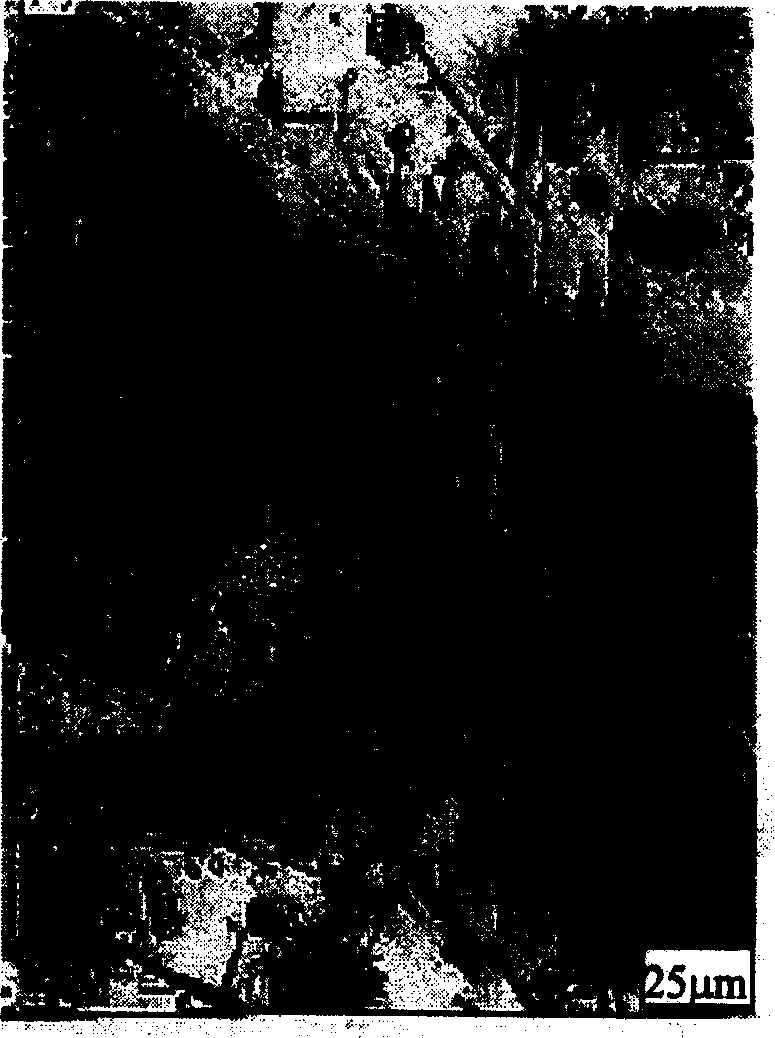Surface or local gradient reinforced wear resistant manganese steel composite material and preparing process
A composite material, local gradient technology, applied in metal material coating process, coating, solid diffusion coating and other directions, can solve the problems of small increase in hardness, waste of energy, increase in viscosity of molten steel, etc. Contradictions of hardness, saving precious alloy resources, and improving work hardening ability
- Summary
- Abstract
- Description
- Claims
- Application Information
AI Technical Summary
Problems solved by technology
Method used
Image
Examples
Embodiment 1
[0028] Preparation of locally strengthened hammerheads for hammer crushers
[0029] The wear of the hammer head mainly occurs at the end, so the end is locally strengthened. Its process steps are as follows:
[0030] 1) Production of cast infiltration layer prefabricated body: high-carbon ferrochrome (60% Cr+6%C+Fe by weight) and ferro-titanium (60% Ti+40% Fe by weight) are mechanically crushed, screened and taken 100-200 mesh particles, mixed evenly with 70% titanium ferro+30% carbon ferrochrome according to the weight percentage, add a small amount of borax and phenolic resin to make a prefabricated block with a thickness of 10mm, the size is equivalent to the size of the end of the hammer head, put it on the water glass quartz At the end of the cavity of the sand mold, there are many pores in the mold to strengthen the exhaust;
[0031] 2) Smelting and pouring: Use scrap steel, ferromanganese, pig iron, etc. to prepare a furnace charge with a carbon content of 0.8% and a ...
Embodiment 2
[0042] Preparation of Blow Bar for Surface Strengthening of Impact Crusher
[0043] The wear of the blow bar mainly occurs on the bottom surface, so the surface layer is strengthened on the bottom layer. The raw materials used are the same as those in Example 1. The infiltration layer is still composed of 70% ferro-titanium + 30% carbon-chromium ferrochrome, and the crushing particle size is about 60-200 mesh. It is molded with water glass quartz sand, and the bottom of the mold is connected with the vacuum pumping box. After setting the core, spread the mixed powder dried at 120°C evenly and loosely on the bottom of the cavity with a thickness of about 10mm. It is still smelted by induction furnace without oxidation. The weight percentage of the designed components is: 1%C, 9%Mn, and the pouring temperature is 1580-1600°C. The in-situ reaction vacuum casting and infiltration synthesis casting method is adopted, and the vacuum degree is about 0.02-0.05MPa.
[0044] After th...
PUM
| Property | Measurement | Unit |
|---|---|---|
| Broken particle size | aaaaa | aaaaa |
Abstract
Description
Claims
Application Information
 Login to View More
Login to View More - R&D
- Intellectual Property
- Life Sciences
- Materials
- Tech Scout
- Unparalleled Data Quality
- Higher Quality Content
- 60% Fewer Hallucinations
Browse by: Latest US Patents, China's latest patents, Technical Efficacy Thesaurus, Application Domain, Technology Topic, Popular Technical Reports.
© 2025 PatSnap. All rights reserved.Legal|Privacy policy|Modern Slavery Act Transparency Statement|Sitemap|About US| Contact US: help@patsnap.com

